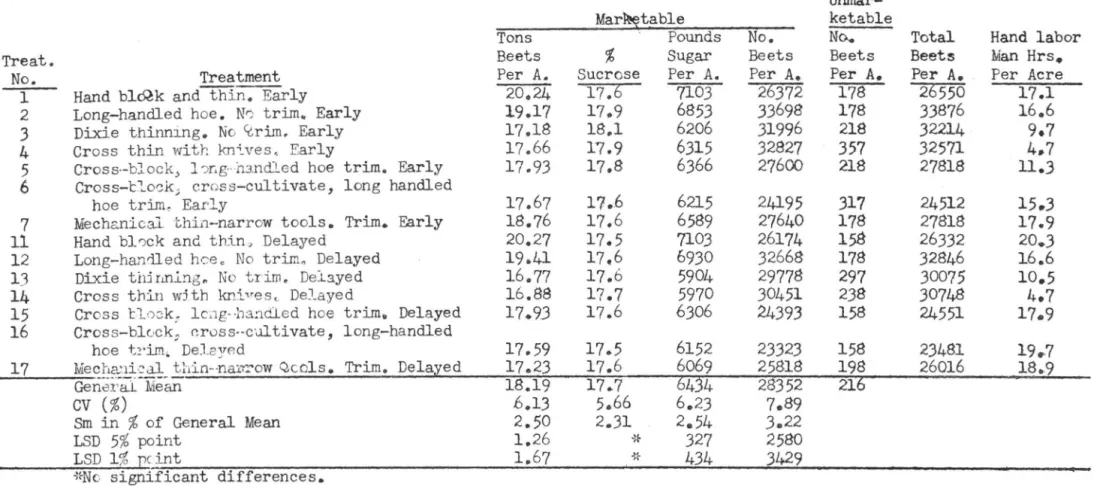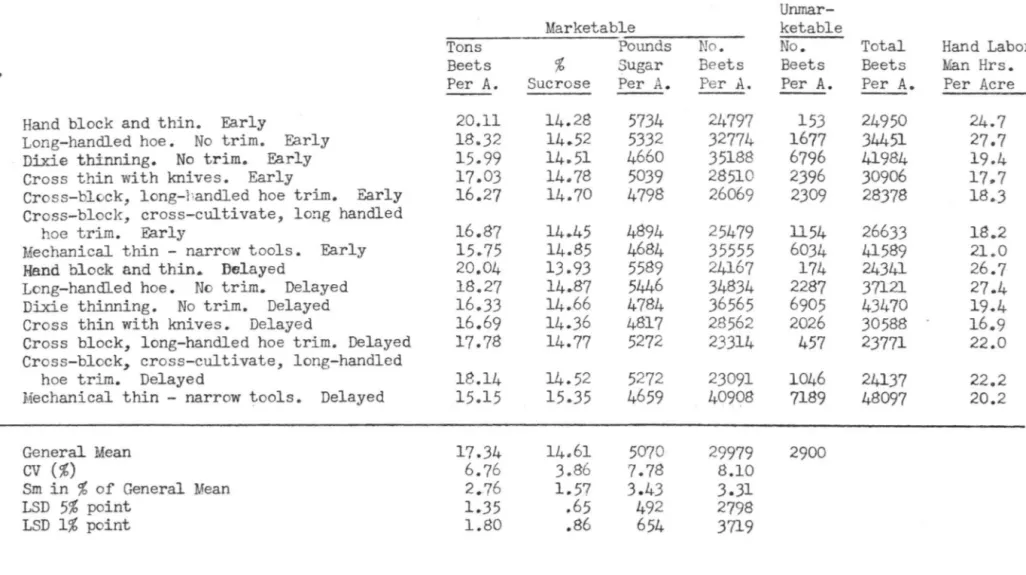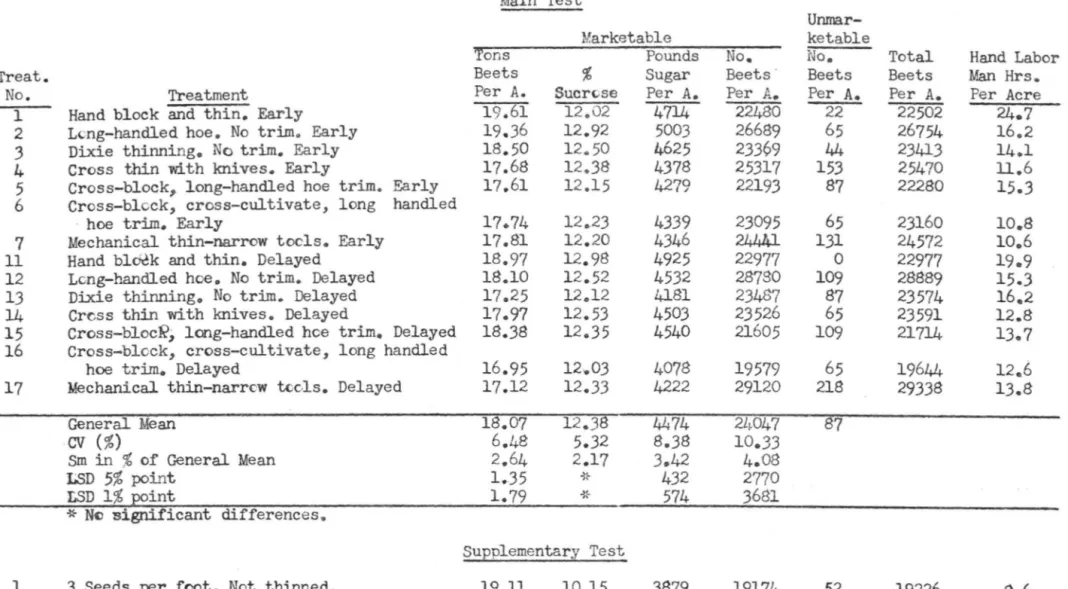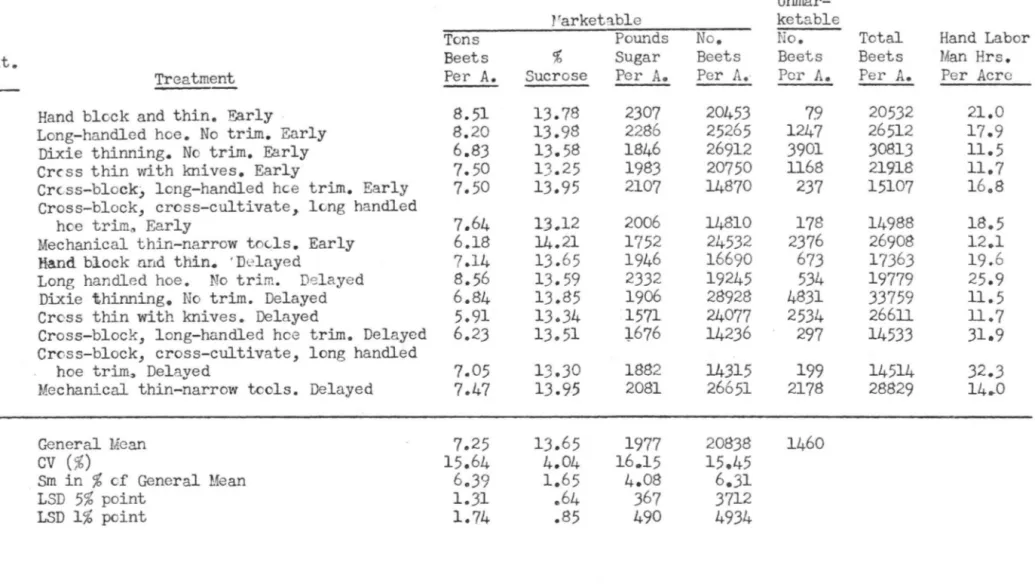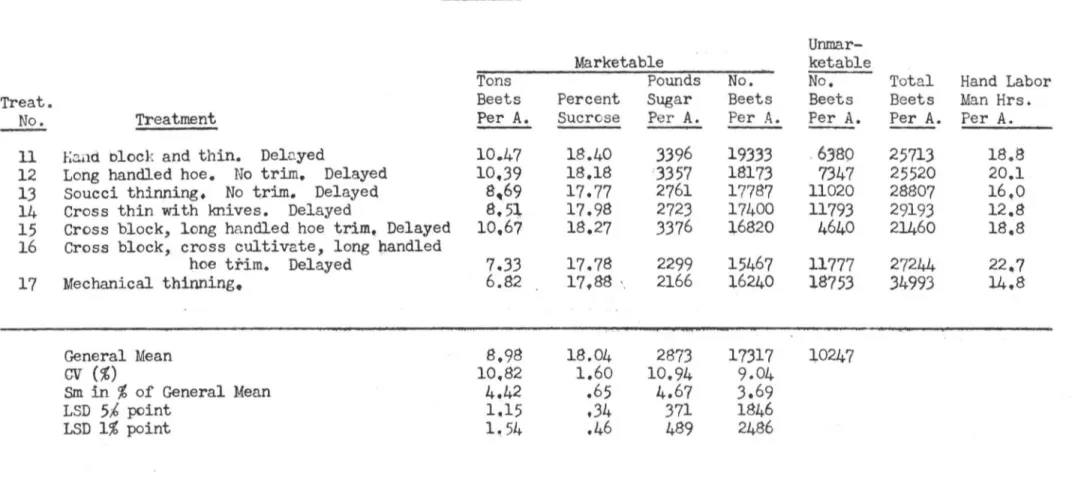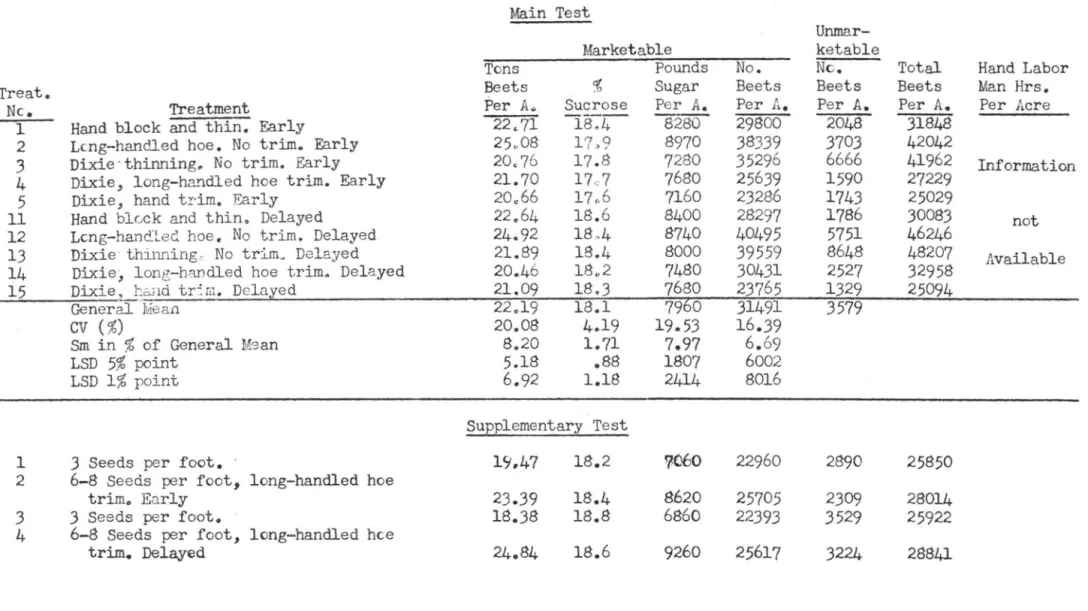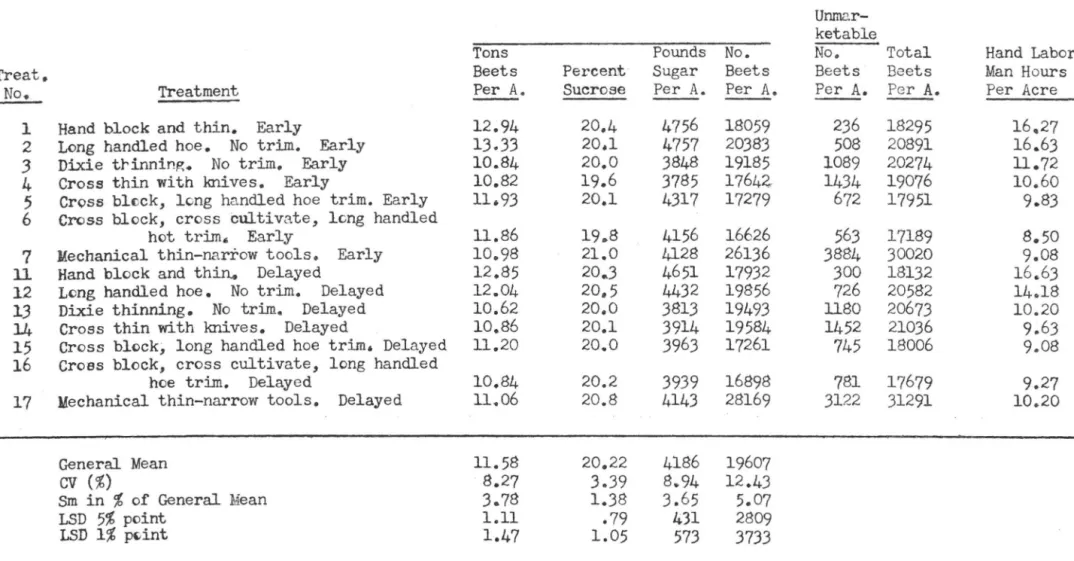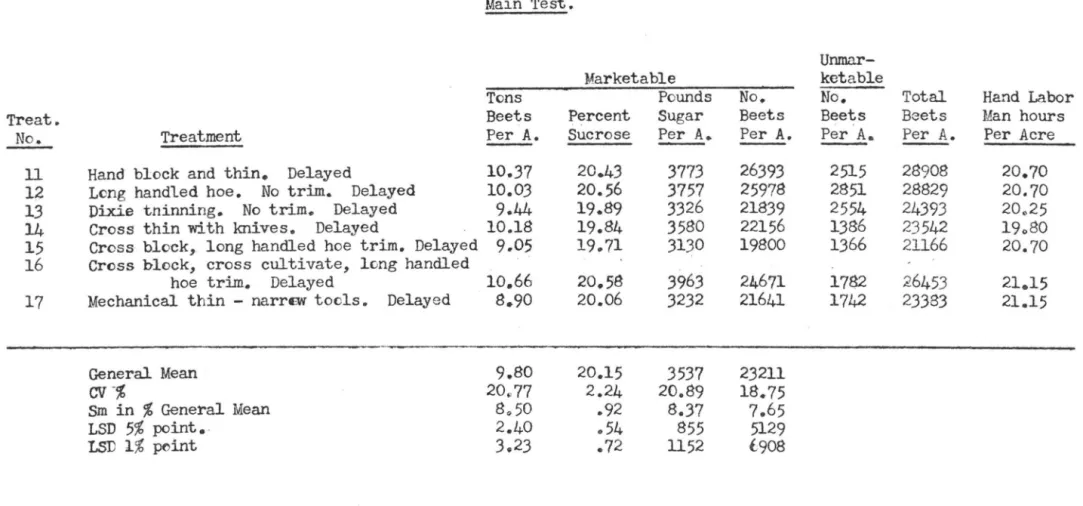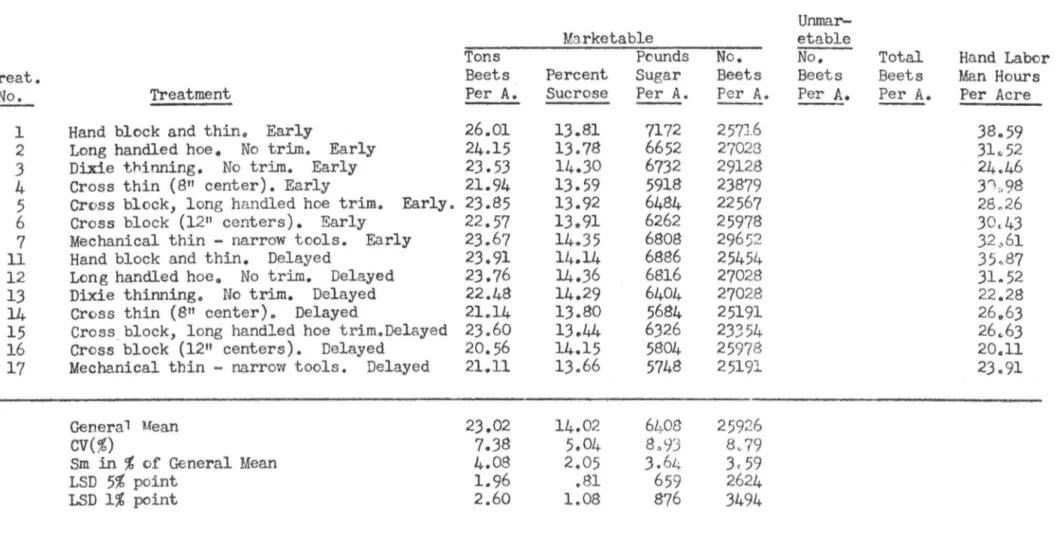t: . . l""
l
'; '
··'\
1946
MECHANICAL THINNING EXPERIMENTS. H.P. H. Johnson*The Foundation Board of Directors met early in
1946
to map out the experi-mental program that should be conducted under Foundation sponsorship in1946.
A mechanical thinning test was one of the things felt necessary. The objective being to d~ter1'1::.ne the difference in yield when thinning was done by hand as com-pared to the ~cr8 complete mechanical methods or long handled hoe or mechanical and long handlec hoe combinations. In order to increase replications as well as get tests sprer.d ou.t over a large number of growing conditions,14
such tests were planned. DuP- to extreme weather conditions in the spring and early summer, two of the tests h3.d to be discontinued leaving 12 to go on for harvest data.The 12 tests being reported on were located in the following processor areas:
1. Billings, Montana
.
.
.
.
• • Great Western Sugar Company 2. Windsor, Colorado. . .
• •.
.
• Great Western Sugar Company3.
Longmont, Colorado,.
. .
.
. .
• Great Western Sugar Comp:my4,
King City, California.
. .
. .
.
Spreckels Sugar Compr~ny5.
Twin Fttlls, Idaho.
.
•.
. .
Amalgamated Sugar Company6.
Idaho Fci.lls, Idaho..
.
•.
. . .
Utah-Idaho Sugar Company7.
Draper, Utah..
•
.
•
.
•. .
.
'
Utah-Idaho Sugar Company8.
Rocky Ford, Colorado..
•.
.
.
.
American Crystal Sugar Co.9.
Torrington, Wyoming •. .
•.
. .
Holly Sugar Corporation 10. st. Louis, Michigan•
.
•. .
•.
Lake Shore Sugar Company 11. Saginaw, Michigan.
.
•. .
.
.
• Michigan Sugar Company 12. Deshler, Ohio.
.
.
• t •.
•. .
Great Lakes Sugar CompanyTests were conducted by the individual processor compP.nies based on re-commendations received from the Mechanical Thinning and Standardization Commit-tee of the Foundation. Similar tests were conducted at some colleges this past se?son, Results from these tests are not included in this paper. These tests were ccnducted ['.t the following colleges:
1. Mont11aa St::ite College 2. Uf:;3.l·: St.0:::.e College
3, U'1~c1n!'sity of Nebraska
A second test at Nebraska had to be discontinued after unfav(')rc'.ble conditions in the spring.
The following plan was outlined as standard procedure for each of the
---~---~~statistician-Agronomist, The Beet Sugar Development Foundation.OUTLINE OF TESTS. I. MAIN TEST:
A. Treatments.
1. Hand block and thin.
2. Long handled hoe thinning with no finger work.
3.
Dixie thinning (no trimming).4.
Cross thin with knives, duckfeet, etc. No trimming.5.
Cross block with knives, duckfeet, etc. Long handled hoetrimming.
6.
Cross block with knives, duckfeet, etc. Cross cultivate at least once ahead of weeding and hoe trimming.?.
Mechanical thinning with special tools using 1 to 2 inch width tools (knife-edge bull-tongues) on cultivator, harrow or other similar tool. No trimming.The above treatments were mnde at the 2 to 4 leaf stage (early thinning). The same treatments were repeated at the 8 leaf stage (delayed thinning)
These treatments were numbered from 11 to 17, the last digit referring back to the
7
treatments listed above.B. Seeding rate: 6 to 8 seed porti~ns per foot (based on local per cent emergence expected).
C. Seed: Common to locality, having high germination and high per cent of single cells.
D. Row widths: 1811 to 2211 depending on local practices.
E. Experimental design: Randomized complete block. Six replications. F. Plots: Approximately 16 feet long and 60 rows wide (plots extended
cross-wise of the rows). The length of the cross blocked plots was determined by making one complete round of the cultivator. Roadways or 12 rows on each side were provided for turning.
G. Di'.ta required: Germination stand counts, thinned stand counts, root yield per acre, percentage of sugar, total sugar yield per acre and time studies. Time study included both thinning and sub.sequent hoeing. Germination stand counts were based on 10-100 ir.ch counts and thinned stand counts were made on the
en-tire plot.
II, SUPPLEMENTARY TEST.
A. Purpose: To compare (1) no thinning on beets planted at a seeding rate of 3 seed portions per foot with (2) long handled hoe thinning on beets planted at 6 to 8 seed portions per foot. Investigation was desired as to possibility of elimination
thinning by using low seeding rates.
-2-B. Seed: Same as for "Main Test".
C. Row widths: Same as fnr 11Main Test".
D. Thinning dates: Same as for 11Main Test".
E. Replicates: Same as for 11Main Test".
F. Experimental Design: Alternate plots of each treatment. Analyzed as paired comparisons. Compnred with treatments in "Main Test" using "long handled hoe" for a check.
G. Plots: 4 to 6 rows in width ( depending on planter used) and at lee.st 300 feet in length.
H. Data required: Same as for 11Main Test11 • STAND COUNTS.
The pre-thinning and after-thinning counts have been summarieed in Table
13.
Tre3tments3, 4,
?,13,
14 and 17 which are all mechanical thinning treat-ments, with no hand or long handled hoe trim show as an average of all tests, up to 55% more plants per 100 feet of row than the hand block and thin treatments. A reflection of the after thinning stand count is npre,rent in the total number of beets per acre at harvest time. These data are reported for each of the tests. It is a logical assumption that the rather wide difference in plant population becomes a factor in influencing yields as well as the way in which the different treatments were thinned. The excessive population would in many instances depress yields.HARVEST RESULTS.
Tables 1 to 12 give summarized harvest data for each of the tests. It is important to note thPt the coefficient of variability (standard error divided by general mean) tends to run higher for number of marketable beets per acre than for tons of beets per acre, in other words, there is greater variation in the number of beets per acre than in Yield in tons per acre. Examining these tables one can frequently find two treatments significantly different in respect to num-ber of marketable beets per acre but with no significant difference in their yields.
The test conducted at King City, California, gives some interesting results on the use of the Dixie. (See Table?). This test, unlike the other 11 in that it w:1..s planted on beds, used the Dixie as the only mech:i.nical device for thinning. The tonnage varies very little for all of the treatments·with Dixie thinning
al~ne, (Treatments
3
and13)
holding its own even with a high acre population. Comparing the "Tons Per Acre" column with the "Number of Marketable Beets Per Acre" colunm, it appears that the higher popul.qtions have the advantage and that not enough beets per acre had been left in most cases.The other 11 tests are summarized in Chart 1. The treatment yields are here expressed in terms of per cent when delayed hand block and thin is taken as 100%.
-3-Delayed hand blnck and thin (Treatment 11) was selected as the check in that it was felt thr.t it most nearly represented the time when the bulk of the thinning was normally done commer~ially. Timely thinning shows up favorably in all treat-ments with Trenttreat-ments
4
and5
being only 8% and6%
less respectively than thecheck. Thinning with narrow tools (Treatments
7
and 17) as well as Dixie thin-ning falls off somewhat. How much of this is due to the heavier acre populations is difficult to determine.TIME COMPARISONS.
Time studies are SlUllllk~rized in Charts 2 and
3.
Chart 2 gives the actual time in hours per acre for each treatment and Chart3
expresses time in per cent when Treatment 11, delayed hand block and thin is taken as 100. Treatments3,
4, 7,
13,14
and 17,all straight mechanical treatments without any hand work orlcng handled hoe show up most favorably ns would be expected. These trentments reauired between 40% and 50% less labor than the delayed hand block and thin. Time required for long handled hoeing following cross blocking was a great deal more for delayed thinning. In some cases, the long handled hoe trim time require-·
ment with delayed blocking tren.tments was greater than long handled hoe used alone.
SUCROSE RESULTS.
There appears to be no pronounced effect between treatments on sucrose per-centage. Although there are significant sucrose differences vdthin given tests, this difference between any set of treatments does not hold true with other tests. If you were to arrange the treatments in order of their sucrose per cent for each test, you would get a table showing a different sequence for each test with no
one treatment holding constant top place. Treatments 7 and 17, if any, might be considered ns being most uniformly near the tcp and Treatments 6 and 16 most con-stantly nenr the bottom. This apparently can be linked up with plant population per acre.
SUPPLEMENTARY TEST RESULTS.
Five of the tests report harvest yields en the "Supplementary Test". The light seeding rate
(3
seeds per foot) compares very favorably with the long hand-led hoe tre[ctment which becomes the check and the means for comparing with trea t-ments in the "Main Test11 • The average time requirement based on all tests was
14.4
hours for long handled hoe and 10.8 hours fer the light seeding rateo Intwo of the tests, however, it became necessary to use long handle hoe trim on the light seeding rate. If time on these two tests were not considered, the time requirement would be 14.43 hours for lcng handled hoe and 6.77 hours for light seeding, a saving of 53% on labor as compared to long handled hoe and with a yield decrease of only 5%. The yield of the light seeding rate was 90% of the long handled hoe yield when all five tests were considered.
The p,~ttern of the pre-thinning stand counts varies between tests with some tests having a large number of single plant hills and relatively few blank gaps. Other tests had more spotted emergence. The uniform spacing of plants is an im-portant factor favoring mechanical t.hLnning and was evidenced in some of these results.
-4-ECONOMIC COMPARISON.
It is interesting to apply a few economic factors to the results of tests
like these. The average yield taken from all tests for Treatment
11,
delayedhand block and thin, which we shall use as the check, is
16,07
tons per acre.The average yield for Treatment 4, early cross thin' ith knives, is 14.80 tons.
The number of hours required for thinning and subsequent hoeings is
23.5
hoursfor Treatment
11
and13.5
hours for Treatment4
(see Chart2).
Assuming theprice of beets as established for
1947,
which$14.50
per ton, and labor at70;
per hour, the following tnble is formulated:
Gross Return Return per acre after spring
Treatment Per Acre Labor Cost thinning and hoeing have been p:i.id.
11
$ 233.02
$16.45
-
$ 216.57
4
214.60
$9.45
=
$205.15
This shows a decrease in earning of
$11.42
for the straight mechanical treatment.One should keep in mind, however, that processed seed in itself has served to de-crease the L:l.bor requirement a great deal. The industry is not far removed from
the time when all planting was made with ungraded whole seed, in fact, about
30%
of the acreage was still planted with this seed in
1946,
with a great deal ofacreage at heavy seeding rates. Previous studies show that yields from such plantings are in excess of one ton less than the processed seed plantings and that time required is at least JO% greater than processed seed when hand blocking and thinning is used on both types of seed. Based on these assumpticns another comparison can logically be made as in the following table:
Gross Return Return per acre after accounting
Treatment Per Acre Labor Cost for deduction of labor costs.
11
$233.02
$16.45
= $216.57
4
$214.60
$9.45
=
$205.15
Ungraded whole seed, hand
block and thin $
217.50
$ 21.35
=
$ 196.15
This table shows mechanical thinning in a more favorable position; a
posi-tion which it has established itself in some conunercial areas and justly so. We
should make comparisons using processed seed combined with mechanical thinning as against the old standard whole seed planting to get the true picture.
SUMMARY.
1. The tests conducted are representative of several beet growing areas and even though rather large variati~ns show up between some of the tests, the
aver-age of all of them gives a reliable guide as to what can be expected when spring
work is accomplished by the described methods.
2, It is apparent that much can be done in improving the tools used for mechanical thinning and more specifically in setting the tools accurately so that
-5-the resulting .plant populations will favor maximum tonnage. In mechanical wor1< the tendency is to leave too many beets. Where populations are held down by proper tool settings a greater saving in labor can be secured as well as making possible comparable yields with hand blocking and thinning.
3.
Uneven distribution of plant population due to planter deficiency and uneven emergence of the seed is reflected in most of the tests.4.
Economically, the straight mech~nical treatments give slightly lower re-returns than hand block and thin but exceed hand block and thin when.ungraded whole seed at the old seeding rates is used as the standard of comparison.Table 1. Mechanical Thinning Test 1946, Billings, Montana (Great, Western Sugar- Co • .) Main Test
Unmar-Mar~table ketable
Tons Pounds No. No. Total Hand labor
Treat. Beets % Sugar Beets Beets Beets Man Hrs.
No. Treatment Per A. Sucrose Per A. Per A. Per A. Per A • . Per Acre
1 Hand bl&k andthin. Early 20.24 17.6 7103 26372 178 26550 17.1
2 Long-handled hoe. N~ trim~ Early 19.17 17.9 6853 33698 178 33876 16.6
3 Dixie thinning. No ~rim, Early 17.18 18.1 6206 31996 218 32214 9.7
4 Cross thin with kn-i_ves ,. Early 17.66 17.9 6315 32827 357 32571 4 .. 7
5 Cross,-block> } ')r,g .. h3.ndled hoe trim. Early 17.93 17.8 6366 27600 218 27818 ll.3
6
Cross-tlor:!k; cross-cultivate, long handledhoe trim, Early 17.67 l?.6 6215 24195 317 24512 15.3
7 Mech.s.nical. thin-narrow tools. Trim. Early 18.76 17.6 6589 27640 178 27818 17.9
11 Hand bl')ck and thin? Delayed 20.27 17.5 7103 26174 158 26332 20.3
12 Long-han".lled hcee No trim. Delayed 19.41 17.6 6930 32668 178 32846 16.6
13 Dixie thfo.nlng. No trim. Deb.yed 16.77 17.6 5904 29778 297 30075 10.5
14 Cross thin wjth kni,res~ DeJayed 16.88 17.7 5970 30451 238 30748 4.7
15 Cross tl.,x;k_, lc1g-·l13.:1dJ.ed hoe trim,. Delayed 17.93 17.6 6306 24393 158 24551 17.9
16 Cross-blc.,ck., r-ross--c·clltivate, long-handled
hoe t~·im. Del2yf?d 17.59 17.5 6152 23323 158 23481 19 .. 7
17 Mecha:.li,~al t1'1in-·na1Y:ow Q.cols. Trim. Dela ed 17.23 17.6 6069 25818 198 26016 18.9
General Mean 18.19 17.7 4 4 28352 21
CV(%) 6.13 5.66 6.23 7.89
Sm in % of General Mean 2.50 2.31 2.54 3.22
LSD 5% point 1.26 {~ 327 2580
LSD 1% pcint 1.67 ~~ 434 3429
~~No significant differences.
Supplementary Test
l Segmented Seed, 3 per ft. Long tiiandle hoe
thinned. 24 •. 63 17.2 8481 2:q4.3:3' 26433 5.4
2 Segmented Seed, 6-8 per ft. Long-handled hoe
thinned.- 24.44 16.9 8277 ~ 27423
6.3
3 Whole Seed, Graded 7-10/64", 6-8 ft. Long
handled hoe thinned. 24.41 17.4 8490 25aro 25800
6.3 4 1'\'hole Seed, 15# per Acre. Hand thin.
Tool Settings:
Notes on Billings, Montana Test
Main Test
Treatments 1 & 11 - Hand block and thin
II 2 & 12 - Long-handle hoe
11 3 & 13 - Dixie. Setting on 9 inch centers with a 7 inch cut
II 0, It
"
General Remarks: nnd a 2 inch block.4 & 14 - Cross thin. Universal knives and flat, cross-blocking duck feet. 7 inch cut and 2½ inch block for duck feet nnd 8 inch cut and 2 inch block for knives. Both
tools .used simultaneously, the knives being placed
ahead of the tractor rear wheels to give slight
addi-tional space for the tire.
5 & 15 - Cross block, long-handled hoe trim. Same
cross-blocking tools as in treatment 4.
6 & 16 - Cross block, cross cultivnte, long handled hoe trim.
Same tool set-up as in treatments 4 and 5 except that
the tire track was cut out to about 10 inches in
V1idth to facilitate subsequent cross cultivation.
Cross cultivation made use of 4 inch duck feet to fit in the 7 inch cut.
7 & 17 - Mechanical thinning -narrow tools. Treatment was
attempted with the spike tooth harrow but even the
early date of thinning was too late to make possible
the removal of a sufficient portion of the plant
pop-ulation. A cultivator set with knife-edge bull tongues gave somewhat better results but still
insuf-ficient reduction in stand was obtnined. Going over
the plot the second time was even not successful.
The treatments were trimmed with the long-handled hoe
to make it acceptable to the grower.
Hand work was done by local Mexican labor which was considered as exce
l-lent labor. There was one subsequent hoeing and 2 subsequent cultivations.
Supplemen t::i,ry Test
Two extra treatments added. One was the adding of a treatment seeded
Hi th grnded whole seed at the rate of 6 to 8 seeds per foot ond then long
-handled hoed and the other seeding 15 pounds of whole seed and hn.nd
thinning, The 3 seeds per foot treatment was too heavy and had to be
long handle hoed. Plots had one subsequent hoeing and no extra cultiva-tions.
Table 2. Mechanical Thinning Test 1946, Rocky Ford, Colorado, (American Crystal Sugar Co.)
Main Test.
-
Unrnar-Marketable ketable
Tons Pounds No. No. Total Hand Labor
Treat. Beets % Sugar Beets Beets Beets Man Hrs.
Ne, Per A. Sucrose Per A.
- -
Per A. Per A.- -
Per A. Per Acre1 Hand block and thin. Early 20.11 14.28 5734 24797 153 24950 24.7
2 Long-handled hoe, No trim. Early 18.32 14.52 5332 32774 1677 34451 27.7
3 Dixie thinning. No trim. Early 15.99 14.51 4660 35188 6796 41984 19.4
4 Cross thin with knives. Early 17.03 14.78 5039 28510 2396 30906 17.7
5
Cross-blvck, long-},andled hoe trim. Early 16.27 14.70 4798 26069 2309 28378 18.36 Cross-block, cross-cultivate, long handled
hoe trim. Early 16.87 14.45 4894 25479 1154 26633 18.2
7 Mechanical thin - narrow tools. Early 15.75 14.85 4684 35555 6034 41589 21.0
11 Hand block and thin~ Delayed 20.04 13.93 5589 24167 174 24341 26.7
12 Long-handled hoe. No trim. Delayed 18.27 14.87 5446 34834 2287 37121 27.4
13 Dixie thinning. No trim. Delayed 16.33 14.66 4784 36565 6905 43470 19.4
14 Cross thin with knives. Delayed 16.69 14.36 4817 28562 2026 30588 16 .. 9
15 Cross block, long-handled hoe trim. Delayed 17.78 14.77 5272 23314 457 23771 22.0
16 Cross-block, cross-cultivate, long-handled
hoe trim. Delayed 18.14 14.52 5272 23091 1046 24137 22.2
17 Mechanical thin - narrow tools. Delayed 15.15 15.35 4659 40908 7189 48097 20.2
General Mean 17.34 14.61 5070 29979 2900
CV(%)
6.76 3.86 7.78 8.10Sm in% of General Mean 2.76 1.57 3.43 3.31
LSD 5% point 1~35 ,65 492 2798
Tool Settings: Treatments ti fl II II fl II General Remarks:
Notes on Rocky Ford, Colorado Test Main Test
l & 11 - Hand block and thin
2 & 12 - Long-handled hoe
3 & 13 - Dixie
4 & 14 - Cross thin with lrnives. Used regular 6 inch knives
making a 9 inch cut and 3 inch block.
5 & 15 - Cross block with knives, long-handled hoe trim.
Same tool setting as in 4 & 14.
6 & 16 - Cross block, cross cultivate, long-handled hoe trim.
Same tool settings~
7 & 17 - Mechanical thinning. Used special i1Tiervine
cross-blocking tool with 4 inch cut and 2 inch block.
Knives were set up in pairs on a bar for each block. Both tool bars were
used. Duck feet were used for cross cu.ltivation, and small duck feet
were also set up on the back tool bar in the crossblocking. Tool used in
treatment 7 is hard to adjust for depth and consequently cutting was made
crui te deep. Immediately after treatment 7 had been thinned a heavy local
rain came giving about one inch of rainfall in 10 minutes. Checking the
field two days later it was found that many of tho cut beets had taken
root again and were growing.
Early thinning was on the deleyed side hence early and delayed thinning
d.D.tes wer(; only one \'!eek apart.
Long-handle hoe thinning was new to the laborers which made for faster
time with short hoc than with the long hoe. There were 3 subsequent
Table 3. Mechanical Thinning Test 1946, "Vindsor, Colorado ( Great V'lestern Sugar Co.) Main Test
Unmar-Marketable ketable
Tons :'cunds No. No~ Total Hand Labor
Treat. Beets % Sugar Beets Beets Beets Man Hrs.
Nu
.
Treatment Per A. Sucrose Per A. Per A. Per A. Per A. Per Acre1 Hand blcck and thin. Early 15.20 13.12 3988 23232 73 23305 17.4
2 Long-handled hoe. No trim. Early 15.05 13.13 3952 25120 218 25338 11.6
3 Dixie thinning. No trim. Early 12.42 13.00 3229 23232 460 23692 8.3
4 Cr~ss thin with knives. Early 13.17 13.28 3498 27007 895 27902
5.5
5 Cross-block, long-handled hce trim. Early 13.67 12.93 3535 22506 339 22845 8.4 6 Cr~ss-block, cross-cultivate, long haneled
hce trim. Early 12.23 12.82 3136 18005 97 18102 12.5
7 Mechanical thin-narrcw tccls. Early 12.15 lJ.08 3178 27298 629 27927 6.3
11 Hand block and thin. Delayed 14 .. 01 13.15 3685 23232 145 23377 30.8
12 Long-handled how,. Ne trim. Delayed 14.18 lJ.18 3738 32234 1089 33323 19.8
13 Dixie thinning. No trim. Delayed 11.60 13.08 3035 23813 750 24563 9.2
14 Cross thin vdth knives. Delayed 12.25 13.20 3234 25410 581 25991 6 •
.3
15 Cross block, long-handled hoe trim~ Delayed 13.09 12.83 3359 24829 411 25240 15.8 16 Cross-block, cross-cultivate, long handled
hoe trim. Delayed 12.94 13.35 3455 20038 411 20449
15.4
17 Mechanical thin-narrow tools. Delayed 11.16 13.52 3018 36445 2977 39422 6.9
General Mean 13.08 13.12 3432 25172
CV(%)
8.40 4.12 9.39 9.60Sm in% of General Mean 3.43 1.68 3.83 3.92
LSD 5% point 1.27 ~~ 372 2780
LSD 1% point 1.69 ~:- 495 3694
*
No significant differences.Supplementary Test
1 3 Seeds per feet. Ne.thinning. 13.24 1.3.67 3620 44721 4791 49512 3.1
Notes on Windsor, Colorado Test Mn.in Test
Tool Settings:
Treatments 1 & 11 - Hand block and thin
11 2 & 12 - Long-hn..-i.dled hoe
11 3 & 13 - Dixie. Setting on 10 inch centers leaving 2 inch
If
II
II
If
block and 8 inch cut.
4 & 14 - Cross thin with knives. Cut 7 inches and block 1 3/4
inches with 8 3/4 inch centers.
5 & 15 - Cross block, long-handled hoe trim. Centers at 12
inches with 3 inch block cmd 9 inch cut.
6 & 16 - Cross block, cross cultivnte, hoe trim. Srune tools
ns for 5
&
15. Cross cultivation with long curvedshnnk duck feet having 4 inch spades.
? & 17 - Mechanical thin-narrow tools. Used harrow with
weights placed on top. Covered plot twice.
General Remnrl:s:
Plots plnnted on April 1 but soil moisture insufficient to bring up beets
for several weeks. When water became available plots were irrigated up.
Germination was very good. Early thinning nas done on June 10 with ver-J
good lo.borers. DEJloyed thinning on June 22 with anot:her group of lc1,borers
not n.s efficient as the first used. Delayed thinning date found beets
very large and hence difficult to work by hand. No benefit gained by
cross cultiv:-,.tlon and the deln.yed trimming following cultivations was
time consuming.
Supplementary Test
The
following table shows number of beets on pre-thinning stand counts:Treatment Beets Per A. ~ Singles
1 2 100362 (a.) 1 ?7767 51.1 40.9 (b)
(n) Even though no thinning was done, less than one half this number of beets aro accounted for in number of beets harvested.
(b) Per cent singles after this treatment was long-handled
Table
4.
Mechanical Thinning Test1946,
Longmont, Colorado ( Great Vie stern Sugar Co O)Main Test
Unrnar-Marketable ketable
Tons Pounds No. No. Total Hand Labor
Treat. Beets % Sugar Beets· Beets Beets Man Hrs ..
No. Treatment Per A. Suorcse Per A. Per A. Per A. Per A. Fer Acre
1 Hand block and thin. Early
19.61
12.02
4714
22480
22
22502
24.7
2
Leng-handled hoe. No trim. Early19.36
12.92
5003
26689
6526754
16
.
2
3 Dixie thinning. No trim. Early
18.50
12.
50
4625
23399
44
23413
14.
1
4 Cross thin with knives. Early
17.68
12.
38
4378
25317
153
25470
u.6
5
Cross-block~ long-handled hoe trim. Early17.61
12.15
4279
22193
87
22280
15.3
6 Cross-blcck, cross-cultivate, long handled
· hoe trim. Early
17.74
12
•
.
23
4339
23095
65
23160
10.8
7 Mechanical thin-narrow tocls. Early
17.81
12.20
4346
24441-
131
24572
10.6
11
Hand bl&k and thin. Delayed18.97
12.98
4925
22977
0
22977
19.9
12
Leng-handled hoe. No trim. Delayed18.10
12.52
4532
28730
109
28889
15.J
13
Dixie thinningo No trim .. Delayed17.25
12.12
4181
23487
87
23574
16.2
14
Cress thin with knives. Delayed17.97
12.53
4503
23526
65
23591
12.8
15
Cross-blocR; long-handled hoe trim. Delayed18.38
12.35
4540
21605
109
21714
13.7
16
Cross-block, cross-cultivate, long handledhoe trim. Delayed
16.95
12.03
4078
19579
65
19644
12 .. 6
17
Mechanical thin-narrcw tcc1s. Delayed17.12
12.33
4222
29120
218
29338
13.8
General Mean
18.07
12.38
4474
24047
87
CV (%)6.48
5.32
8.38
10.33
Sm in % of General Mean2.64
2.17
3.
42
4.08
LSD5%
point1.35
.,~
432
2770
LSD1%
~int1.79
if-574
3681
*
N~ significant differences. Supplementary Test1
3
Seeds per foot. Not thinned.19.11
10.15
3879
19174
52
19226
8.6
2
6-8 Seeds per foot. Leng-handled hoetrim. Early
19.40
10.
51
4078
21000
52
21052
16.3
3
3
Seeds per foot. Not thinned.20.14
12.54
5051
18102
0
18102
8.
6
4.
6-8
Seeds per foot. Long-handled hoeTool Settings:
Notes on Longmont, Colorado Test Main Test
Treatments l & 11 - Hand block and thin
11 2 & 12 - Long-handled hoe
11 3 & 13 - Dixie. Setting made for 10 inch centers with a 6 inch
cut and 4 inch block.
" 4 & 14 - Cross thin. Duck feet set to cut 6 inches and leave
4 inches.
11 5 & 15 - Same tools & settings as 4 & 14. Long-handled hoe
"
.
II
General Remarks:
trim.
6 & 16 - Cross block, cross cultivate.long-handled hoe trim,
Same tools and setting as for 4 & 14. Cross cul ti
-vated once with bull tongues before using long-handled hoe.
? & l? - Mechanical thinning-narrow tools. Used bull tongues on cultivator bar making al½ inch cut and leaving 2½ inches.
The initial stand on all treatments was rather thin which no doubt made
for smnller differences between early and delayed thinning. T'.ae thinning
was done in tho four and eight leaf stage. The two dates differed by
only 9 days. The same lnbor was used for each thinning.
Supplementary Test
A very good stand of beets was obtained from the 3 seeds per foot seeding
rnte. The following table shows the number of beets per acre based on
pre-thinning sta.nd counts:
Treatment 1 2 3 4 Beets Per A. 22456 44410 22338 44863 ~ Singles ?3.2 67.8 77.3 75.6
Table
5.
Mechanical Thinning Test1946,
Torrington, Wyoming (Holly Sugar Co.)Main Test
Unmar-Varkeb.ble ketable
Tons Pounds No. No. Total Hand Labor
Treat. Beets % Sugar Beets Beets Beets Man Hrs.
Ne. Treatment Per A. Sucrose Per A. Per A.· Per A. Per A. Per Acre
1
Hand block and thin. Early8.51
13.78
2307
20453
79
20532
21.0
2
Long-handled hoe. No trim. Early8.20
13.98
2
2
8
6
252
6
5
1247
26512
17.9
3
Dixie thinning. No trim. E.arly6.83
13.58
1846
26912
3901
30813
11.5
4
Cress thin with knives. Early7.50
1
3
.25
1983
20750
1168
21918
11.7
5
Cr0ss-block; long-handled hce trim. Early7.50
13.95
2107
14870
237
15107
16.8
6
Cross-block, cross-cultivate, lcng handledhoe trim" Early
7.64
1)
..
12
2006
14810
178
14988
18.5
,.., Mechanical thin-narrow to~ls. Early
6.18
14.21
1752
24532
2376
26908
12.1
I11
Hand block nnd thin. ·Delayed7.14
13.65
1946
16690
673
173
6
3
19.
6
12
Long handled hoe. No trim. Delayed8.56
13.59
2332
19245
534
19779
25.9
13
Dixie thinning. No trim. Delayed6.84
13.85
1906
28928
4831
33759
11.5
14
Cross thin with knives. Delayed5.91
13.34
1571
24077
2534
26611
ll.7
15
Cross-block, long-handled hce trim. Delayed6.23
13.51
1.676
14236
297
14533
31.9
16
Cross-block, cross-cultivate, long handledhoe trim3 Delayed
7.05
13.30
188
2
14315
199
14514
32.3
17
Mechanical thin-narrow tools. Delayed7.47
13.95
2081
26651
2178
28829
14.0
General Mean
7.25
13.65
1977
20838
1460
CV(%)
15.64
4.04
16.15
15.45
Sm in% cf General Mean
6.39
1.65
4.08
6.31
LSD
5
%
point1.31
.64
367
3712
Tool Settings:
Notes on Torrington, Wyoming Test Main Test
Treatments 1 & 11 - Hand block and thin
11 2 & 12 - Long-handled hoe
If II
"
II II General Remarks:3
&13
4
&14
5
& 156
&16
7
&17
- Dixie- Cross thin with knives. Used Planet Jr. knives on 8½
inch centers making l½ inch bl(')cks and
7
inch cuts.- Cross block long handled hne trim. Used Planet Jr.
knives on
9!
inch centers making 2! inch blocks and7
inch cuts.
- Cr~ss blo~k, cross cultivate, long handled hoe trim.
Same knife setting as in
5
& 15.- Mechanical thinning with narrow tools. Spring tooth
alfalfa renovator was used. This machine had to be used a second time in order to reduce populations so
they were somewhat comparable with hand block and
then treatment populations.
Excellent Mexican laborers were used. These laborers were not experienced
in using the long handle hoe. The early thinning was made a little on the
late side making the delayed thinning quite late when beets were well in
the 8 - leaf stage. It took laborers longer to long, handle hoe following
Treat. No. 11 12 13 14 15 16 17
Table 6. Mechanical Thinning Test 1946, Saginaw, Michigan (Michigan Sugar Co.)
Main Test.
Treatment
l-~3.nci block and thin. Delayed
Long handled hoe. No trim. Delayed
Soucci thinning. No trim. Delayed Cross thin with knives. Delayed
Cross block, long handled hoe trim, Delayed
Cross block, cross cultivate, long bandled hoe trim.
Mechanical
thinning.
General Mean
CV(%)
Sm
in%
of General MeanLSD
5/4
point LSD1%
point Delayed Tons Beets Per A. 10.47 10.39 8~69 8,5:\ 10.67 7.33 6.82 8.98 10.82 4.42 1.15 1.54 Marketable Percent Sucrose 18.40 18,18 17.77 17.98 18.27 17.78 17.88 ', 18.04 1.60 .65 ,34 .46 Pounds Sugar Per A. 3396 3357 2761 2723 3376 2299 2166 2873 10.94 4.67 371 489 No. Beets PerA.
19333 18173 17787 17400 ],.6820 15467 16240 17317 9.04 3,69 V!46 2486 Unmar-ketable No. Beets Per A. -. 6J80 7347 11020 11793 4640 11777 18753 ],.0247Total Hand Labor
Beets Man Hrs. Per A. Per
A.
-25713 18.8 25520 20.1 28807 16,0 29193 12.8 21460 18.8 27244 22~7 .34993 14.8Table
7.
Mechanical Thinning Test1946,
King City, California (Spreckels Sugar Co.) Main Test
Unmar-Marketable ketable
Tons Pounds No. Ne. Total Hand Labor
Treat. Beets % Sugar Beets Beets Beets Man Hrs.
Ne. Treatment Per A., Sucrose Per A. Per A. Per A. Per A. Per Acre
1
Hand block and thin. Early22,71
18.4
828029800
2048
31848
2
Leng-handled hoe. No trim. Early25,.08
1
7,9
8970
38339
3703
42042
3 Dixie-thinning. No trim. Early
20
~76
17.8
7
280
35296
6666
41962
Information4
Dixie, long-handled hoe trim. Early21.70
17
"
7
7680
25639
1590
27229
5
Dixie, hand t:r-im. Early20.66
17,
,6
71
6
0
23286
1743
25029
11
Hand bl0ck and thin. Delayed22.64
18.
6
8400
28297
1786
30083
not12
Lcng-hanQLed hoe. No trim. Delayed24.92
18
~
4
8740
40495
5751
46246
13
Dixie· thinning.- No trimv Delayed21.89
18.4
8000
39559
8648
48207
Available14
Dixie, lone-h~ndled hoe trim~ Delayed20 .. 4
6
18,
.
2
7480
30431
2527
32958
15
Dixie i__:':.a.Hd tr~r11. Delayed21.09
18.3
7680
237
65
1329
25094
General lviean
22.19
18.1
7960
31491
3579
CV (%)
20.08
4.19
19.53
16.39
Sm in% of General Mean
8.20
1.71
7.97
6.
6
9
LSD
5%
point5.18
.88
1807
600
2
LSD
1%
point6.92
1.18
2414
8016
Supplementary Test
1
3
Seeds per foot. ·19,47
18.2
'i1C6022960
2890
25850
2
6-8
Seeds per foot, long-handled hoetrim. Early
23.39
18.4
8620
25705
2309
28014
3
3 Seeds per foot.18.38
18.8
6860
22393
3529
25922
4
6-8
Seeds per foot, long-handled hceTool Settings:
Notes on King City, California Test Main Test
Treatments 1 & 11 - Hand block and thin
n 2 & 12 - Long-handled hoe
n 3 & 13 - Dixie. Set for
6
inch centers leaving 2 inch blocksII
II
General Remarks:
4 & 14
and 4 inch cuts.
Dixie followed by long-handle hoe. Same setting as in
3
&13.
5
& 15 - Dixie followed by hand trim. Same setting as in3
&13.
Time data sheets arrived too late to permit making the proper records hence
man hours per acre is omitted. It was noted, however, that labor both by
use of long-handled hoe and hand work was able to move along more rapidly
following a Dixie than when no Dixie was used.
These plots were placed on beds which did permit cross the row tools. Rows
were spaced at 14 inches on the beds and 26 inches between beds. Three
subsequent hoeings were made and 5 subsequent cultivations.
Supplementary Test
Paired comparisons were conducted on a field not adjacent to the main
Table 8. Mechanical Thinning Test 1946, Twin Falls, Idaho (Amalgamated Sugar Co.) Main Test
Urunar-Marketable ketable
Tons Pounds No. No. Total Hand Labor
Treat. Beets
%
Sugar Beets· Beets Beets :M.an Hrs.No. Treatment Per A. Sucrose Per A. Per A. Per A. Per A. Per I.ere
1 Hand block and thin. Early 21.35 17.57 7500 20673 1070 21743 19.1.
2 Long-handled hoe. No trim. Early 22.42 17.67 7920 22107 1579 23686 17.0
3 Dixie ~hinning. No trim. Early 20.41 17.95 7340 32307 4701 37008 11.3
4 Cross thin with knives. Early 20.06 17.37 6960 28ll5 3248 31363 10.7
5 Cross-block, long-handled hoe trim. Early 20.30 16.98 6900 16153 944 17097 16.3
6 Cross-block, cross-cultivate, long-handled
hoe trim. Early 19.30 16.55 6400 15355 1143 16498 14.8
7 Mechanical thin-narrow tools •. Early 19.17 17.37 6660 22071 2396 24467 10.9
11 Hand block and thin. Delayed 20.63 16.80 6920 19257 1434 20691 18.8
12 Long-handled hoe. No trim. Delayed 21.76 17.48 7620 24049 1578 25627 15.6
13 Dixie thinning. No trim. Delayed 19.87 17 .35 6900 26444 3013 29457 ll.5
14 Cross thin with :mives. Delayed 20.49 17.78 7280 28314 2850 3ll64 10.7
15 Cross block~ long-handled hoe trim. Delayed 19.87 17.03 6760 16934 1324 18258 14.1
16 Cross-block, cross-cultivate, long-handled
hoe trim. Delayed 20.45 17.25 7060 16299 943 17242 13.l
17 Mechanical thin...,narrow tools. Delayed 20.12 17.53 7060 27189 1815 29004 ll.3
General Mean 20.44 17.33 7091 22518 1989
CV(%)
6.82 2.88 7.48 10.40Sm in% of General Mean 2.78 1.18 3.05 4.25
LSD 5% point 1.61 .• 58 611 2701
LSD 1% point 2.13 .76 813 3590
Supplementary Test
1
3
Seeds per foot. 15.45 17.3 5340 47807 47807 28.3Tool Settine;s: Treatments fl II II II II II General Remarks:
Notes on Twin Falls, Idaho Test
Main Test
1 & 11 - Hand block and thin on 14 inch centers
2 & 12 - Long-handled hce on 14 inch centers
3 & 13 - Dixie. Set on 9 inch centers with a 3 inch block and
6 inch cut.
4 & 14 - Cross thinning. Used John Deere knives set on 12 inch
centers • . Left a 4 inch block,
5 & 15 - Cross block, long-handled hoe trim. Same tools and
settings as with 4 & 14.
6 & 16 - Cross block, cross cultivate, long-handled hoe trim.
Same tools and settings as with 4 & 14.
7 & 17 - Mechanical thin-narrow tools. Used Self Weeder with
3
inch diamond points. Set to make a l inch block and3 inch cut.
Used Mexican laborers rated as good. Had one subsequent hoeing.
Supplemental Test
Made one subsequent hoeing on long-handled hoe thinned plots and 2 weed
hoeings on unthinned plots which were seeded at the rate of
3
seeds perTreat. No. 1 2
3
45
6 7 l l 121.3
u.
15
16
17Table 9. Mechanical Thinning Test 1946, St. Louis, liichigan (Lake Shore Sugar Co.)
Treatment
Hand block and thin. Early
Long handled hoe. No trim. Early Dixie
tr
inning. No trim. Early Cross thin with knives. EarlyCross blcck, long handled hoe trim. Early Cross block, cross cultivate, lcng handled
hot trim, Early
Mechanical thin-narrow tools. Early Hand block and thin. Delayed
Long handled hoe. No trim. Delayed
Dixie thinning. No trim. Delayed Cross thin with knives. Delayed
Cross blcck, long handled hoe trim. Delayed Croes block, cross cultivate, long handled
hoe trim. Delayed Mechanical thin-narrow tools.
General Mean CV (%)
Sm in% of General Mean LSD 5% point LSD 1% P"int Delayed Main Test. Tons Beets Per A.
-12.94 13.33 10.84 10.82 11.93 11.86 10.98 12.85 12.04 10.62 10.86 11.20 10 .. 84 11.06 11.58 8.27 3.78 1.11 1.47 Percent Sucrose 20.4 20.1 20.0 19.6 20.1 19.8 21.0 20 .. 3 20.5 20.0 20.1 20.0 20.2 20.8 20.22 3.39 1.38 .79 1.05 Pounds Sugar Per A. 4756 4757 3848 3785 4317 4156 4128 4651 4432 3813 3914 3963 3939 4143 4186 8.94 3.65 431 573 No. Beets Per A. 18059 20383 19185 17644 17279 16626 26136 17932 19856 19493 19584 17261 16898 28169 19607 12.43 5.07 2809 3733 Unrnar-ketable No. Beets Per A.
-236 508 1089 1434 672 563 3884 300 726 1180 1452 745 781 3122
Total Hand Labor
Beets Man Hours
Per A. Per Acre 18295 16.27 20891 16.63 20274 ll.72 19076 10.60 17951 9.83 17189 8.50 30020 9.08 18132 16$63 20582 14.18 20673 10.20 21036 9.63 18006 9.08 17679 9.27 31291 10.20
Table 10. Mechanical Thinnin~ Test 1946, Deshler, Ohic. (Great Lakes Sugar Co.) Main Test.
Unmar-Marketable ketable
Tons Pounds No. No. Total Hand Labor
Treat. Beets Percent Sugar Beets Beets Beets Man hours
No. Treatment Per A. Sucrose Per A. Per A. Per A. Per A. Per Acre
- -
-11 Hand block and thin. Delayed 10.37 20.43 3773 26393 2515 28908 20.70
12 Leng handled hoe. No trim. Delayed 10.03 20.56 3757 25978 2851 28829 20.70
13 Dixie tninning. No trim. Delayed 9.44 19.89 3326 21839 2554 24393 20~25
14 Cross thin with knives. Delayed 10.18 19.84 3580 22156 1386 23542 19080
15 Cross block, long handled hoe trim. Delayed 9.05 19.71 3130 19800 1366 21166 20.70
16 Cross block, cross cultivate, long handled
hoe trim. Delayed
10.66
20.58 3963 24671 17$2 26453 21.1517 Mechanical thin - narrEW tocls. Delayed 8.90 20.06 3232 21641 1742 23383 21.15
General. Mean 9.80 20.15 3537 23211
ctr%
20~77 2.24 20.89 18.75Sm in% General Mean 8050 .92 8.37 7.65
LSD
5%
point •. 2.40 .54 855 5129Table 11. Mcehanical Thinning Test 1946, Draper, Utah. (Utah-Idaho Sugar Company) Main Test
Unmar-Marketable etable
Tons Pcunds No. No. Total Hand Labor
Treat. Beets Percent Sugar Beets Beets Beets Man Hours
No. Treatment Per A. Sucrose Per A.
- -
Per A.- -
Per A. Per A. Per Acre1 Hand block and thin. Early 26.01 lJ.81 7172 257J.6 38.59
2 Long handled hoe. No trim. Early 24.15 13.78 6652 27028 31.,52
3 Dixie thinning. No trim. Early 23.53 14.30 6732 29128 24.46
4 Cross thin ( 811 center). Early 21.94 13.59 5918 23879 31:a98
5 Cross block, long handled hoe trim. Early. 23.85 13.92 6484 22567 28n26
6 Cross block (1211 centers). Early 22.57 13.91 6262 25978 30,43
7 Mechanical thin - narrow tools. Early 23.67 14.35 6808 29652 32.,61
11 Hand block and thin. Delayed 23.91 14.14 6886 25454 35,;87
12 Long handled hoe., No trim. Delayed 23.76 14.36 6816 27028 31.52
13 Dixie thinningo No trim. Delayed 22.48 14.29 6404 27028 22.28
14 Cross thin (811 center). Delayed 21.14 13.80 5684 25191 26063
15 Cross.block, long handled hoe trim.Delayed 23.60 13.44 6326 23354 26~63
16 Cross block (1211 centers). Delayed 20.56 14.15 5804 25978 20.11
17 Mechanical thin - narrow tools. Delayed 21 .. 11 13.66 5748 25191 23.91
General Mean 23.02 14.02 6~.08 25926
CV(%)
7.38 5.04 8,93 8.79Sm
in%
of General Mean 4.08 2.05 3.64 3,59LSD 5% point 1.96 .81 659 2624
Table
12.
Mechanical Thinning Test1946,
Idaho Falls, Idaho. (Utah-Idaho Sugar Co.) Main Test
Unmar-Marketable ketable
Tons Pounds Vo. No. Total Hand Labor
Treat. Beets Percent Sugar Beets Beets B0ets Man Hours
No. Treatment Per A. Sucrose Per A. Per A.
- -
Per A. Per A. Per A.1
Hand block and thin. Early18.56
16.34
606420790
238
21028
22.52
2 Lor g h1=1.ndled hoe. No trim. Early
17.38
17.08
5938
20552
594
21146
31.13
3
Dixie thinning. No trim. Early14.97
17.22
5144
22572
2020
24592
10
.
60
4
Cross thin(8
11 center). Early16.55
16.71
5534
22334
2020
24354
12,5
8
5 Cross block, long handled hoc trim. Early
16.56
16.81
5568
18414
238
1
86
52
21
_,
19
6
Cross block(12
11 center). Early15.47
16.83
5190
20433
1663
22096
10
,
60
7
Mechanical thin-narrow tools. Early14.52
16.72
4862
20790
1426
22216
11.26
11 Hand block and thin. Delayed
18.11
16 •
.
90
5472
20909
238
21147
22.52
12
Long handled hoe. No trilll. Delayed18.ll
17
.
04
6114
19839
475
20314
20.53
13
Dixie thinning. No trim. Delayed14
.
41
17.07
4924
25067
2495
27564
10
.
60
14
Cross thin (8
11 center). Delayed14.62
16.74
4898
20671
1901
22572
11.26
15
Cross block, long handled hoe tr:im.Delayed15.49
16.52
5122
20790
1307
22097
11.26
16
Cross block(12
11 center). Delayed14063
16.19
4766
2l740
2614
24354
11
<2
6
17
Mechanical thin - narrow tools. Delayed14.12
16.63
4690
19958
2376
22334
11.92
General Mean
15.97
16 .. 77
5354
21146
1426
CV(%)
11.04
2.37
11.29
11 .. 50
Sm in
%
of General Mean6.39
1.37
6.52
6,64
LSD
5%
point2.96
.67
1014
.4071Table
13.
Pre-Thinning and After Thinning Stand Counts.Plants per
100
feet.Area in Ave. Pre- Average After Thinnin~ Counts
which test thinning TREATMENT NUMBER
conducted count
1
-
23
45
-
6
7
11
12
13
14
15
16
17
Billings
397.0
10401 131
.
8 129.8 130.5
96.3
9Ju.b1L 101:.a102.6 117.5 114.8 105.6
ao.6
88
87.3
Deshler
200.6
86'>.
~ .. 8~A ?-3c.: 6-5:.~75 .. 7
79.7
96.2
Longmont
233,.4
93.8 100.-5
90.7
95.7
80.5
84.3
9r.
·
r
8'r.y;" llb-;1i:: 86;$ .-89
i-
5
L
.78.165~0
114.5
st.
Louis198
84.3
96
.
3 105.J
92.7
80.7
79.3 148.7
90.2
90.7
104.2
98.i88.7
90.7 151.2
Rocky Ford
589.0
104
155
260
157
150
123
237
95
151
246
152
108
102
3ll
Saginaw
444.7
140.5 134
14~-ll- 153
126.1 141
167
Torrington
359
85.6 103.8 123.1
82.l
63.1
53.5 126
80.5
74.6 152~6 118.6
63.6
61.5 128.6
Twin Falls
299.6
93.5
96.8 140.1 131.6
75.3
62.2
89~595.0 107~2 103~3 125
..
2
77.2
73e7
l16.7
Windsor
607~8
97
.
0
98.5 10005 109~5
98.8
66.5 132.0 102.5 177;3 138
;
5 141.5
107.3
76.0 2.38;3
Draper
292.5
98.3 103.,0 110.0
90.9
86.4
98
..
9*
113.2
95.3 103.2 102.8
96
.1
88.6
98$9* 95~6
Idaho Falls
103 ..
8
97
.
7 142.5 126.7
86.7 120.3* 132.0
97.0 107.2 131.7 122.0 124.2 127.7* 122.0
AVERAGE
362.2
96.0 109.3 133
.
6 113.0
90.0
79.9 130 .. 2
97.5 115.0 125.3 115.2
92.6
86.4 148.0
*
Cross blocked with12
inch centers - no subsequent cross cultivation.-a Thinned with Soucci.
1. Hand block and thin. Early
11.
Hand block and thin. Delayed2. Long handled hoe. No trim. Early
1
2.
Long h~ndled hoe. N~ trim. Delayed3
.
Dixie thinning. No trim. Early13.
Dixie thinning. No trim. Delayed4. Cross thin with knives. Early 14. Cross thin with kinves. Delayed
5.
Cross block, long handled hoe trim. Early15.
Cross block, long h:l.ndled hoe trim. Delayed6
.
Cro~s block, cross cultivate, long handlGdhoe trime Early
7
.
Mechanical thin - narrow tools. Early16.
Cross block, cross cultivate, long handledhoe trim. Del~ycd
I 110;
'
100(~
f-t <I; J ,-..::i l ~ 80/ I'
11ol
1.o
; ..
. ,
..
treatment- l 11CHART NO. 1 RELATIVE YIELDS OF DIFFli.'RP.JlT TREATMENTS
DELAYED HJ\ND BLOCK AND THIN IS FIGURED /1.S 100% AVERJ,GE OF ELEVEN TESTS.
102.2 2 12 3
13
~~i
.~
\i
;
...
~;_,. :::;~;: '.i),i.-::7'. ~-~-::~_:,-:~; r-, ,~ti:"\; l~1::::::.:~ -~;l
~
/
J/:
i
i:~~:~:
~
494.2
~;,!>~-
:
-XmJ)!
~
-_
ii
tJ
14
717
1 ! ! J 20! I I I I 161 l
o
l
22.4 Treatment- 1 23.5 11CHART NO. 2. AVERAGE NUMB-SR OF HOURS REQUIR:D FOR THINNING AND SUBSEqUENT HOEING AND CULTIVATION FOR BACH TREATJ\illNT BI,SED ON NINE TESTS.
20.8 17.8 ,-:.· _:_~ 16.2
13.5
=---· -12 .9_ 12.3 12 313
I '--l-14
6 , 14_.6 717
100: 100
.
80( 50; 40; .. 10;o
:
Tr
e
atni
e"r
1t
·
-
1 .. ,~···-·ii
CHART NO. 3 RELATIVE TH!E REQUIRED FOR THINNING, AND SUBSEC}UENT HOEING AND CULTIVATION FOR EACH TREATMENT BASED ON NINE TESTS.
